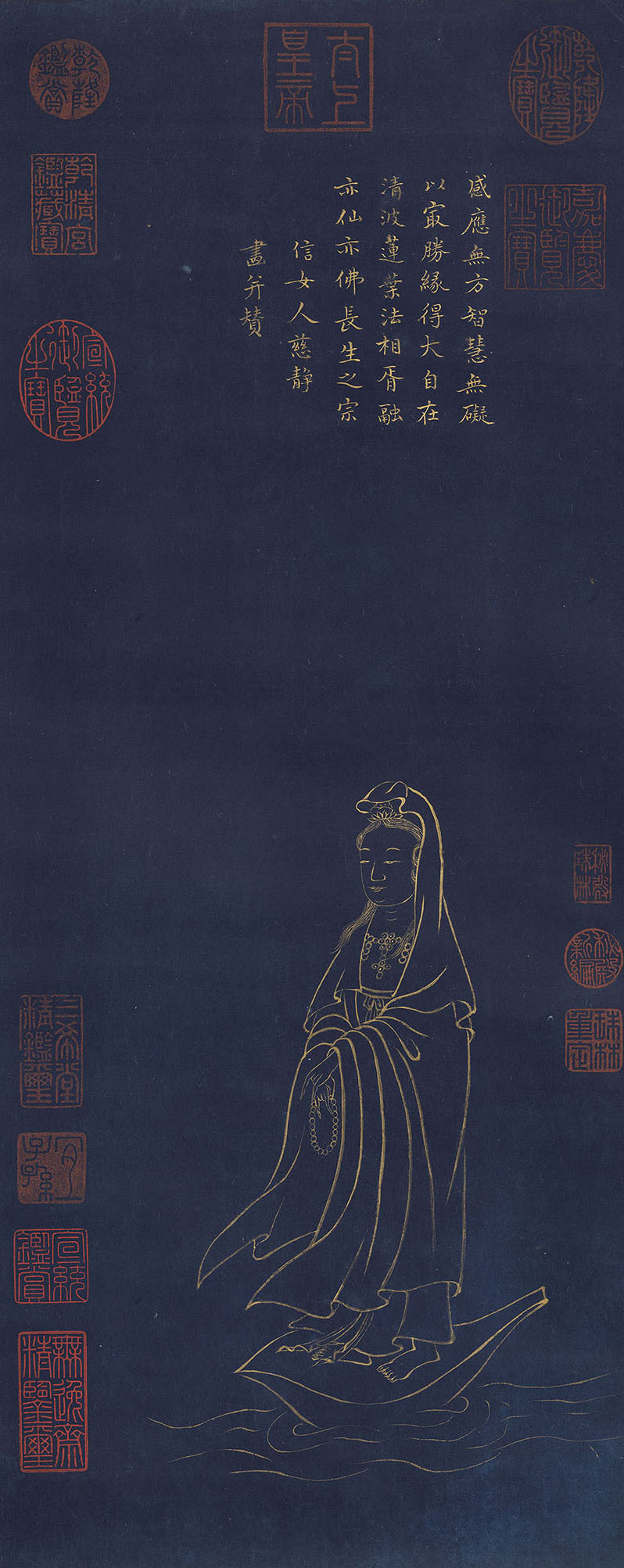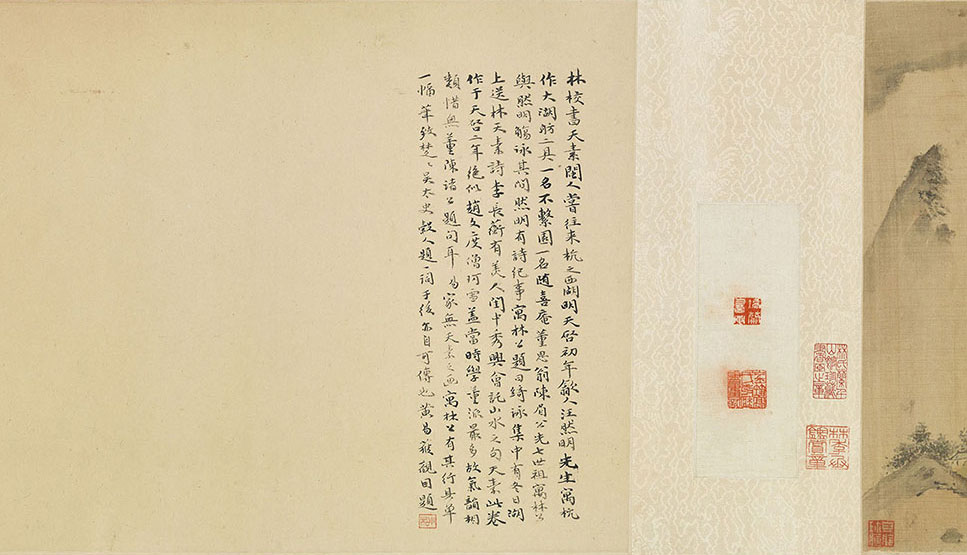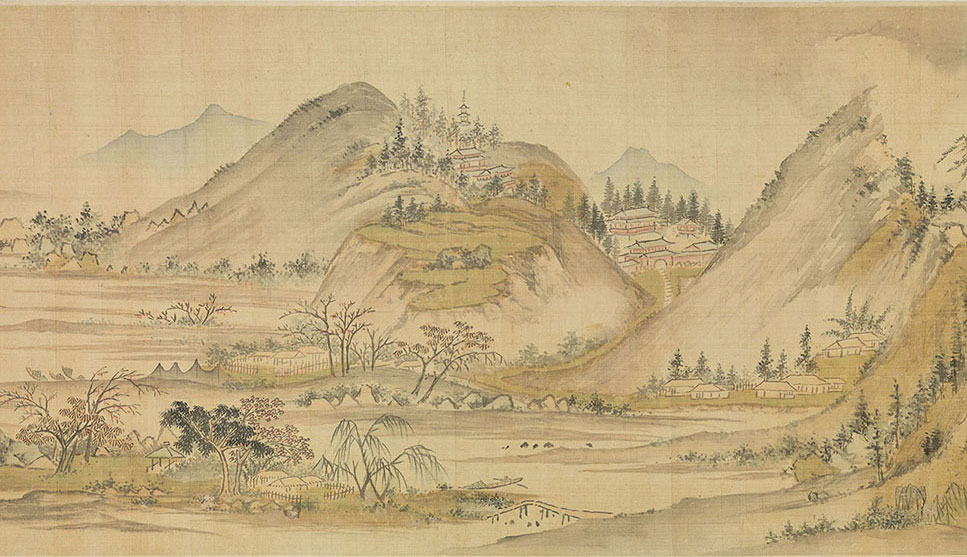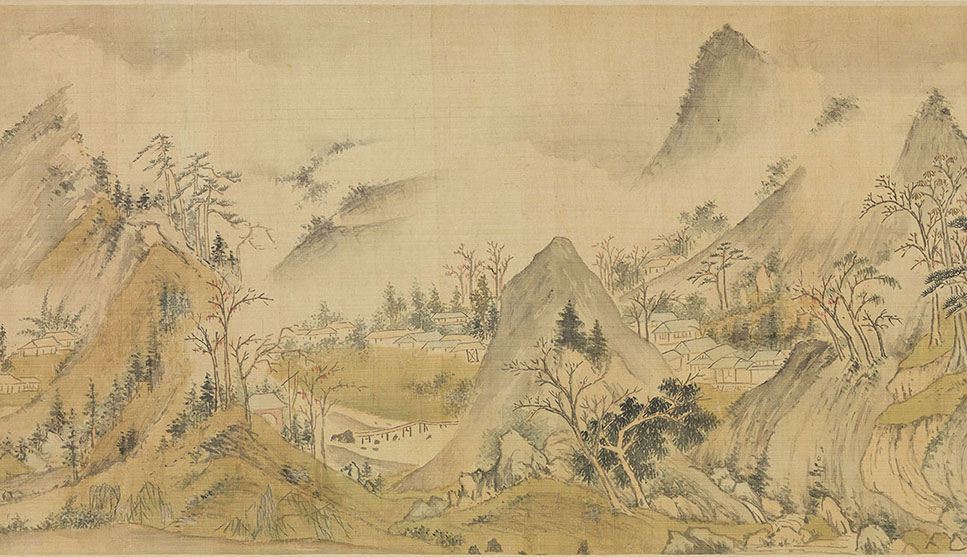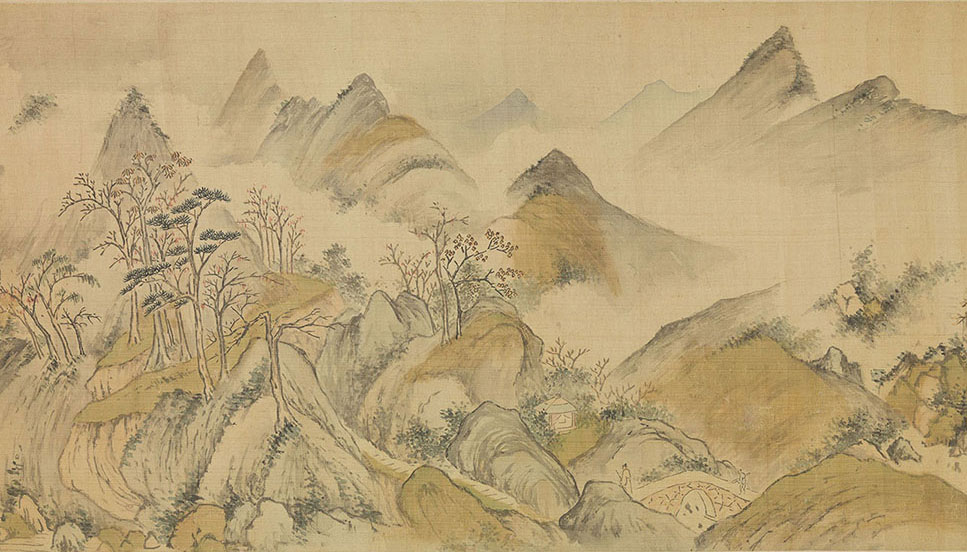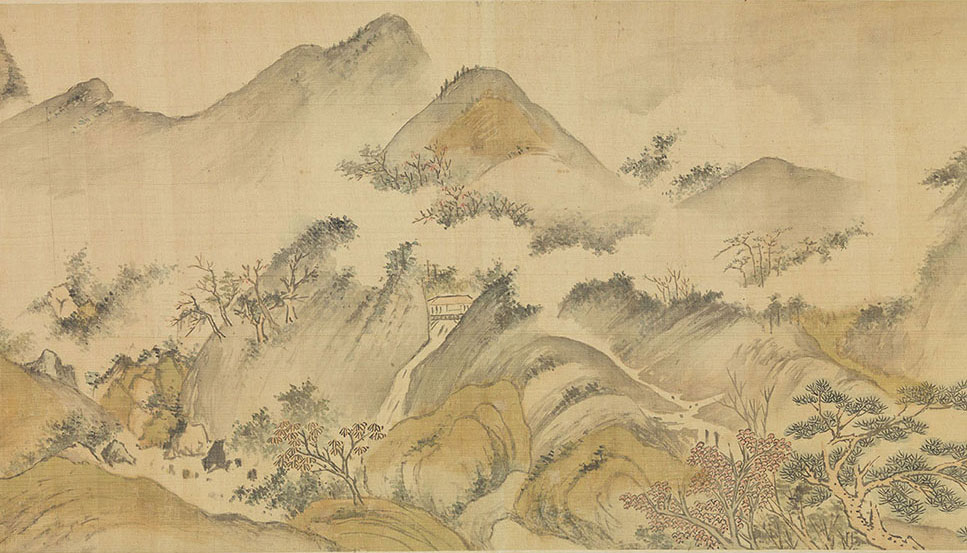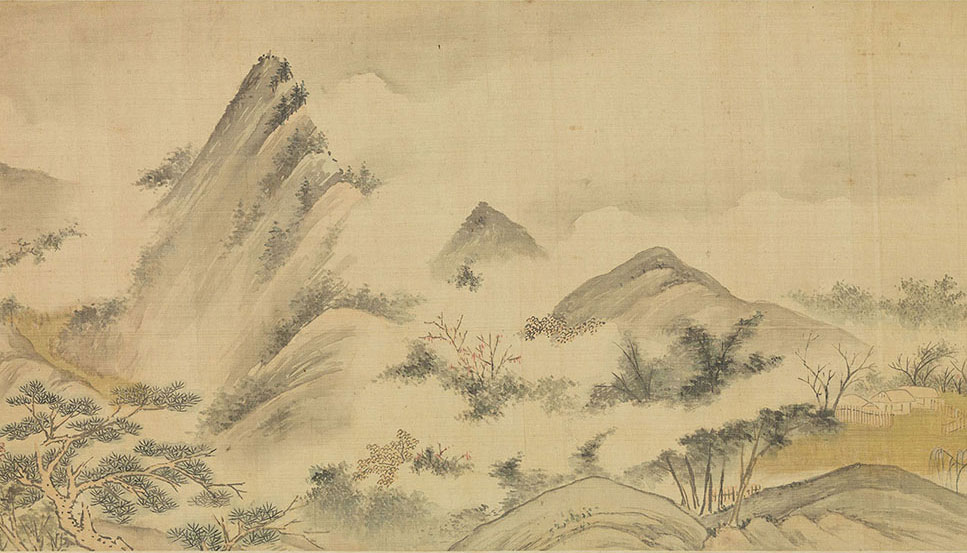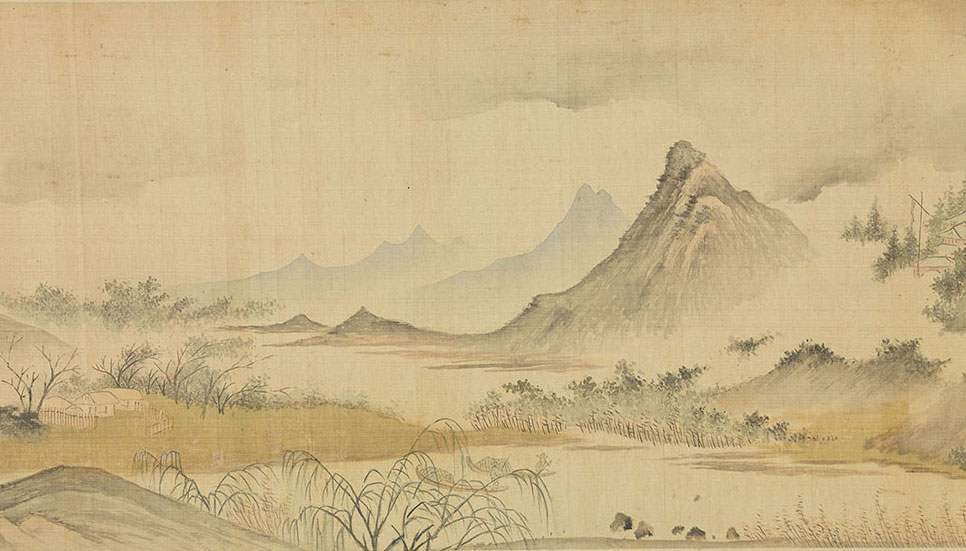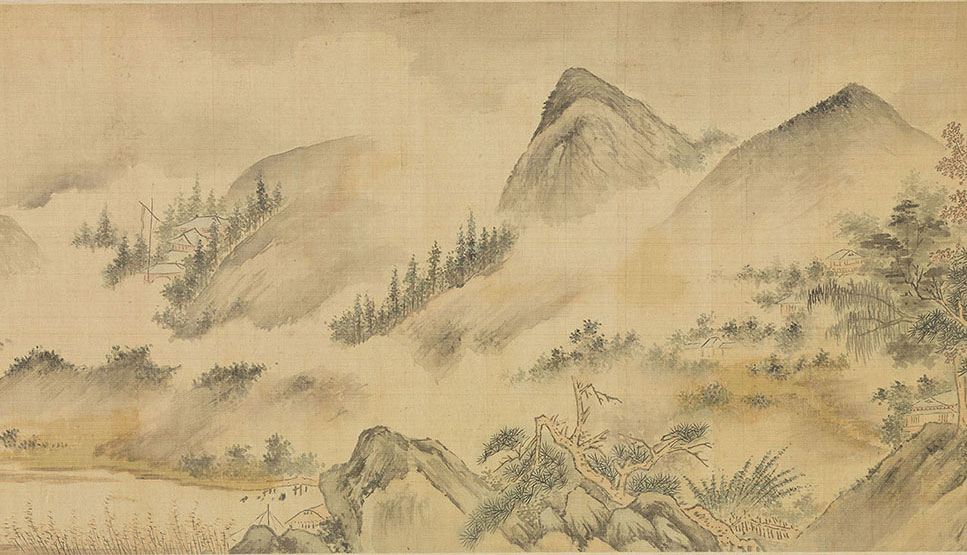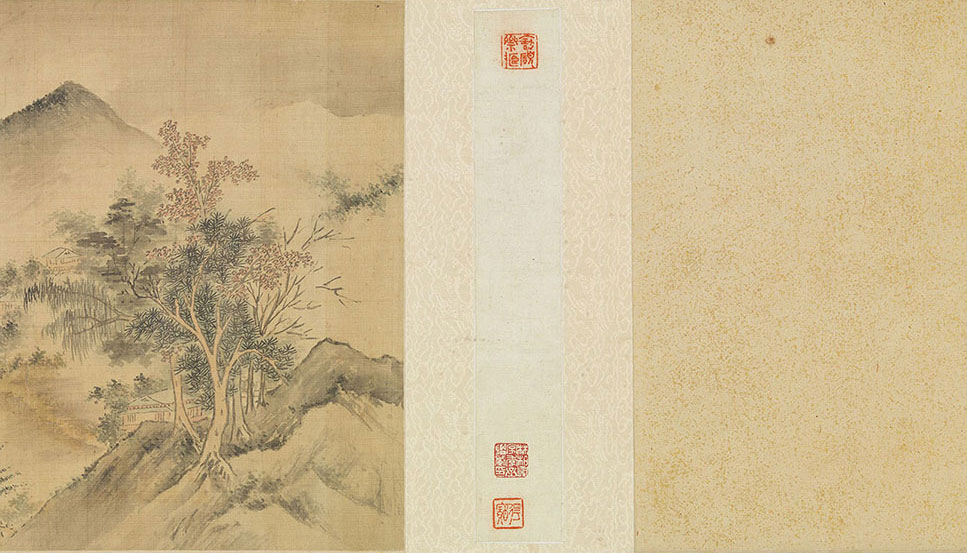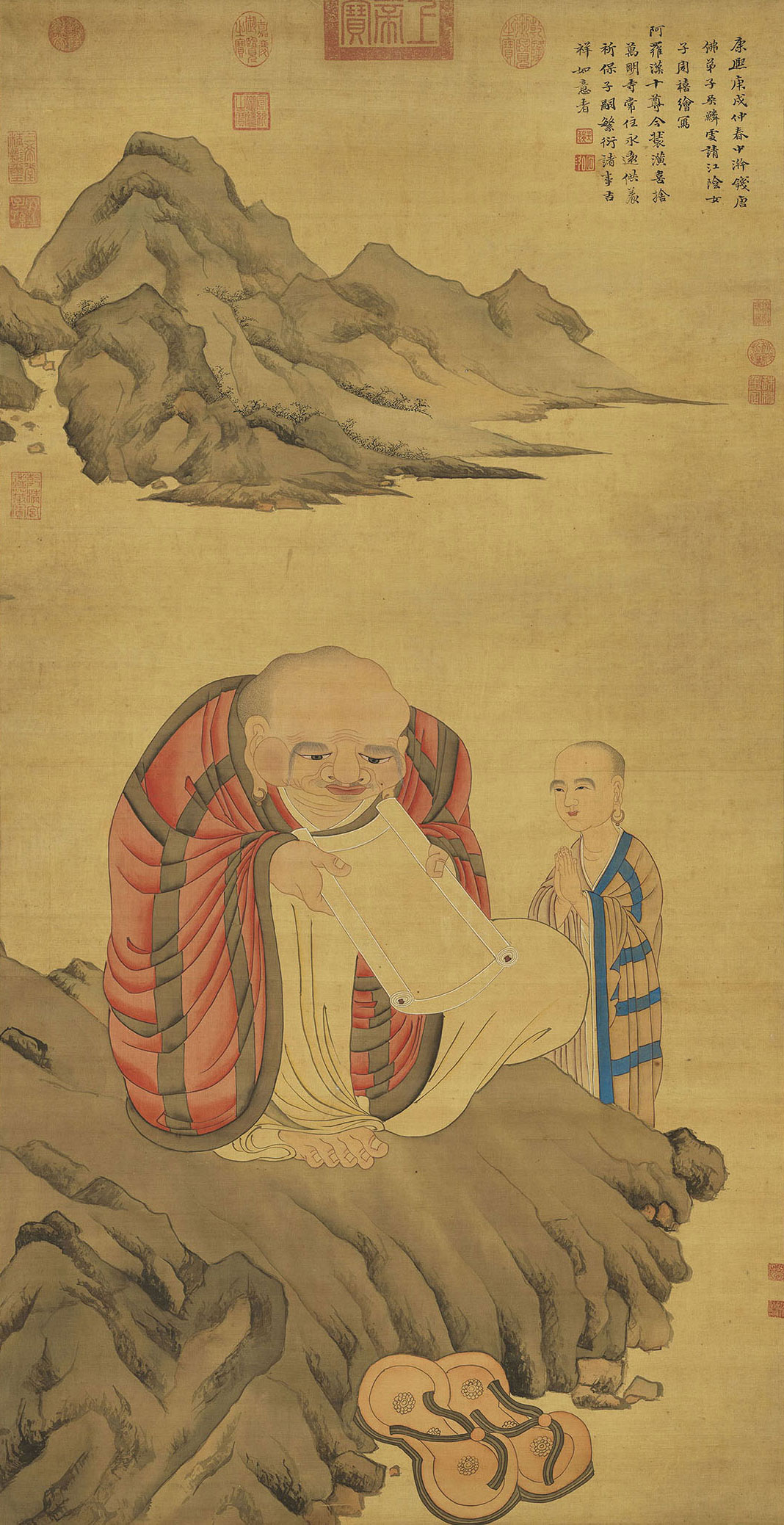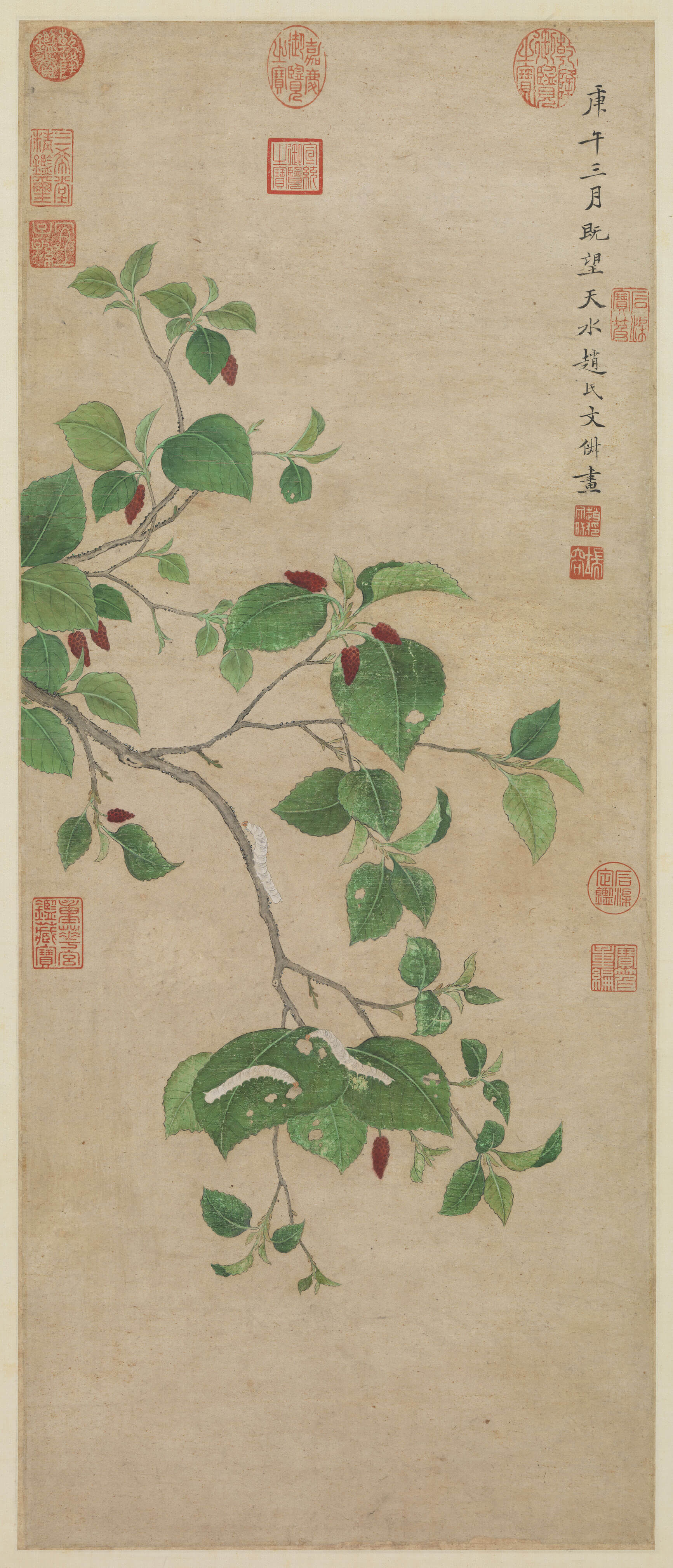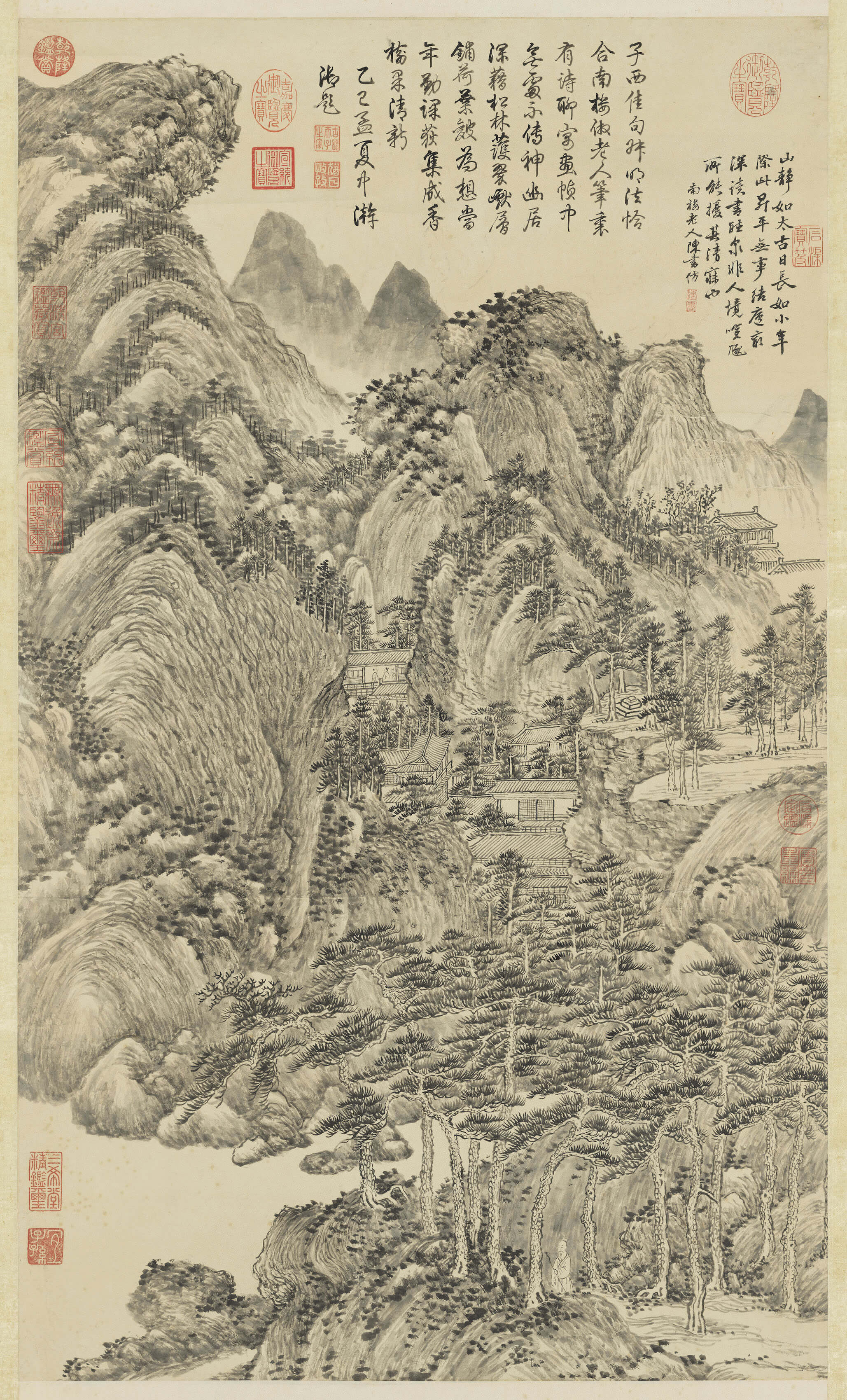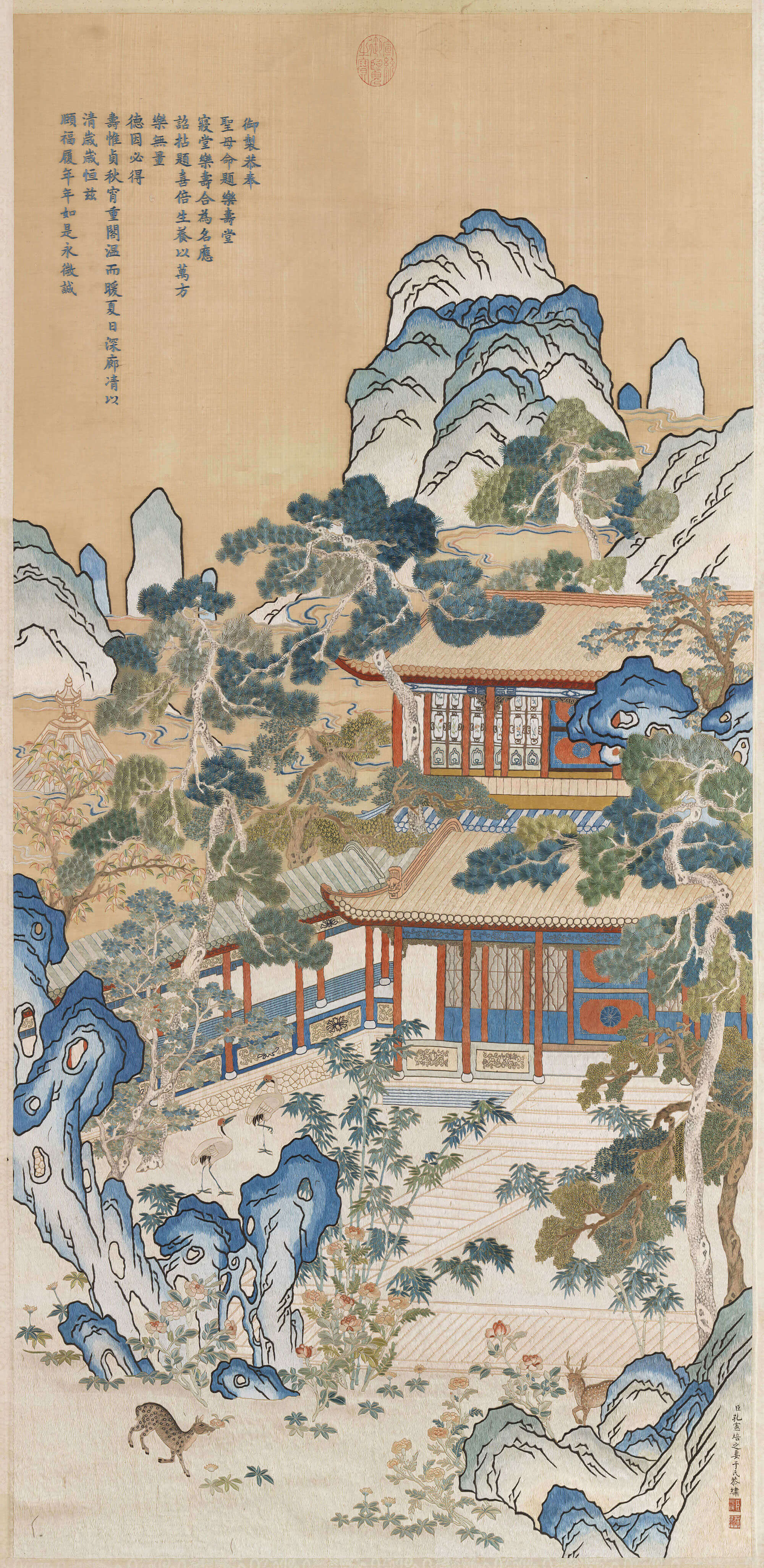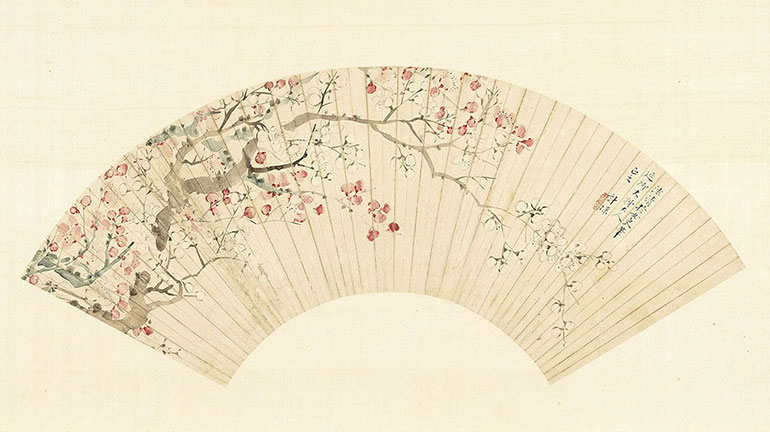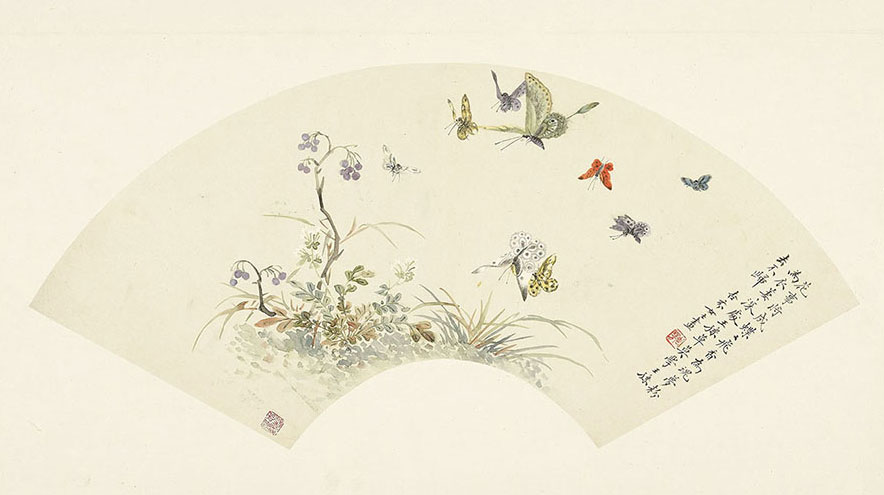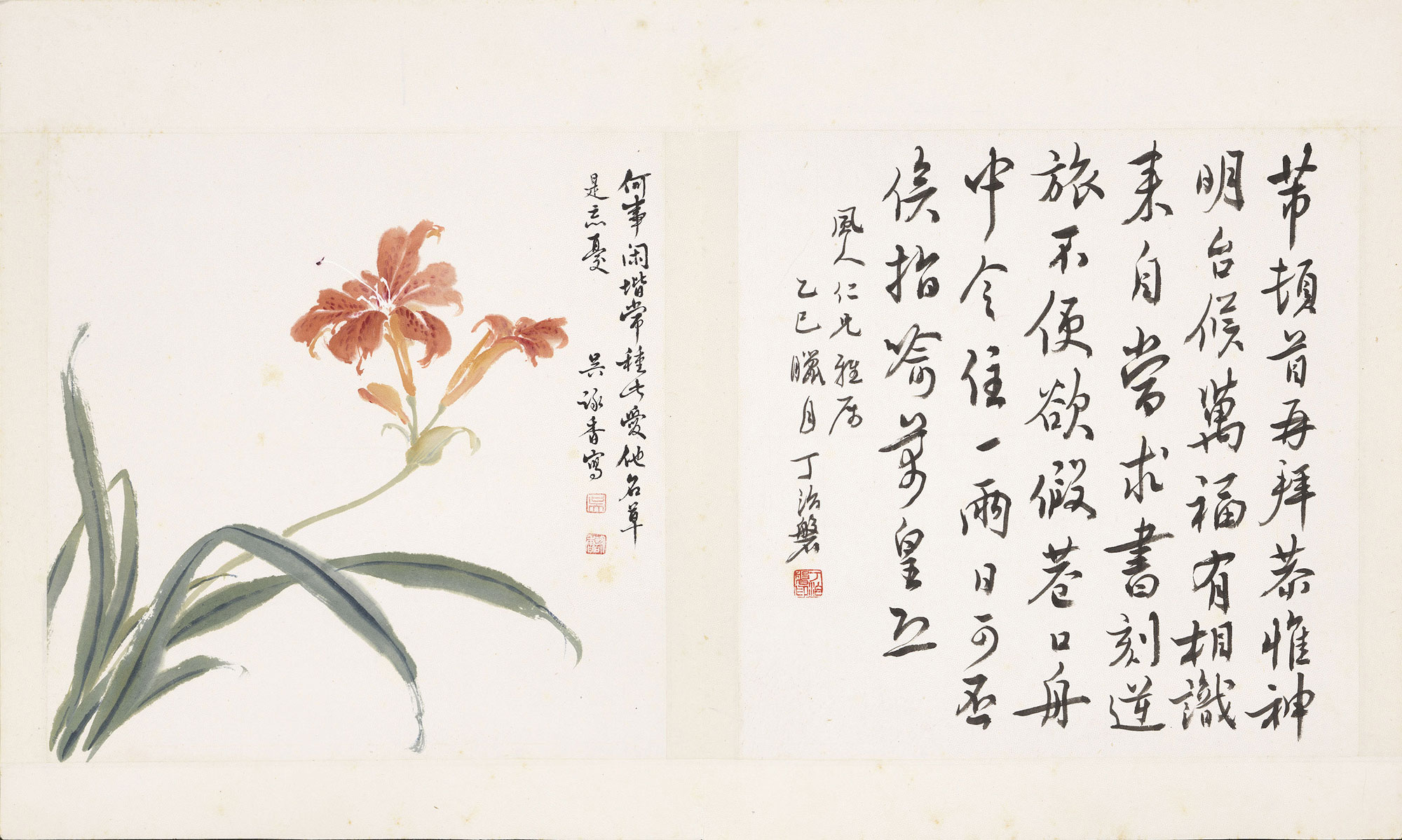Ladies of Artistic Talent
The idea of "heavens high and earth low" was interpreted by male scholars in the patriarchal Chinese society of the past as "men above and women below" to explain the relative status of the sexes. This fallacy accepted as truth went against the harmony and balance of nature to become a part of the traditional cultural consciousness, leading to the role determination of women for thousands of years in Chinese society. Though legend has it that "painting started with Lei" (the younger sister of legendary emperor Shun), most women in fact were excluded from art circles over the course of history and their names often lost. Ladies in the past were rarely allowed to venture outside the house, but many still overcame obstacles and restraints in an effort to display their talents. In a world of art and its history dominated by men, they shine with particular radiance.
This part of the exhibit features works of painting, calligraphy, and the textile arts of tapestry and embroidery that span the Song to Qing dynasties. These remnants of "her" story in the annals of Chinese art history are found in the former Qing palace holdings that now make up the bulk of the National Palace Museum collection. Also selected here are works by modern women artists from the Republican era that upend the traditional notion of "a girl without talent" and hopefully will encourage more women to continue and form new ideas of the self.
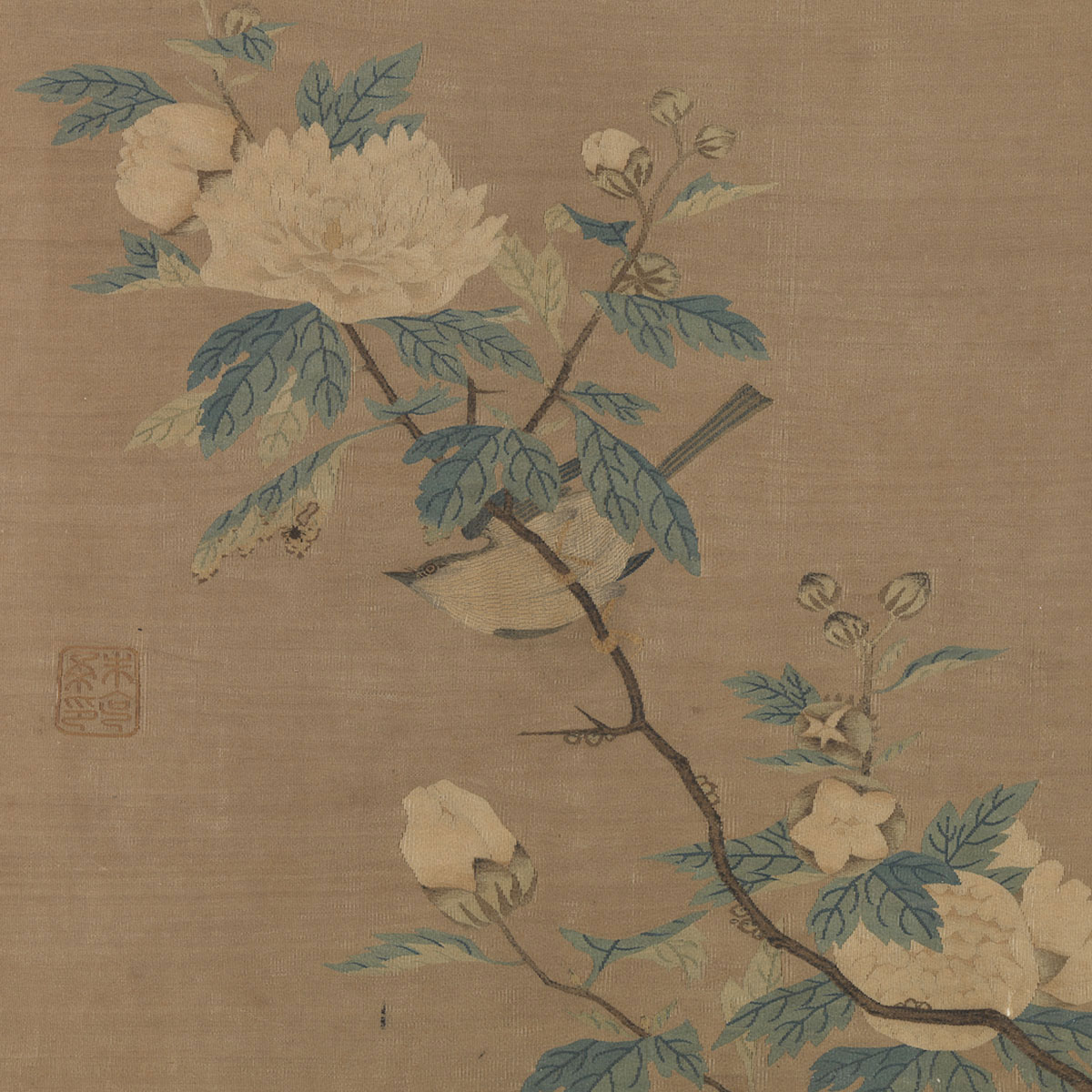
Bird and Flowers
- Zhu Kerou, Song dynasty (960-1279)
Zhu Kerou, whose birth and death dates are unknown, went by the name Gang and was a native of what is modern-day Songjiang in Shanghai. She learned the art of weaving silk tapestry in childhood and amassed a wealth of experience on how to combine different colored threads and do needlework, becoming a famous tapestry artist of the Southern Song period (1127-1279).
Woven against the light brown background of this work is a peony branch with blossoms or in bud. A magpie sitting on the branch has spotted and gazes at a small insect on the edge of a leaf. The bird appears as if it will take flight any second and pounce upon the insect. This scene of beauty but also a moment of tension in the natural world has been skillfully rendered via delicate needlework into a tight-knit scene. The strands are also even, enhancing the volume and giving the motifs a glossy effect.
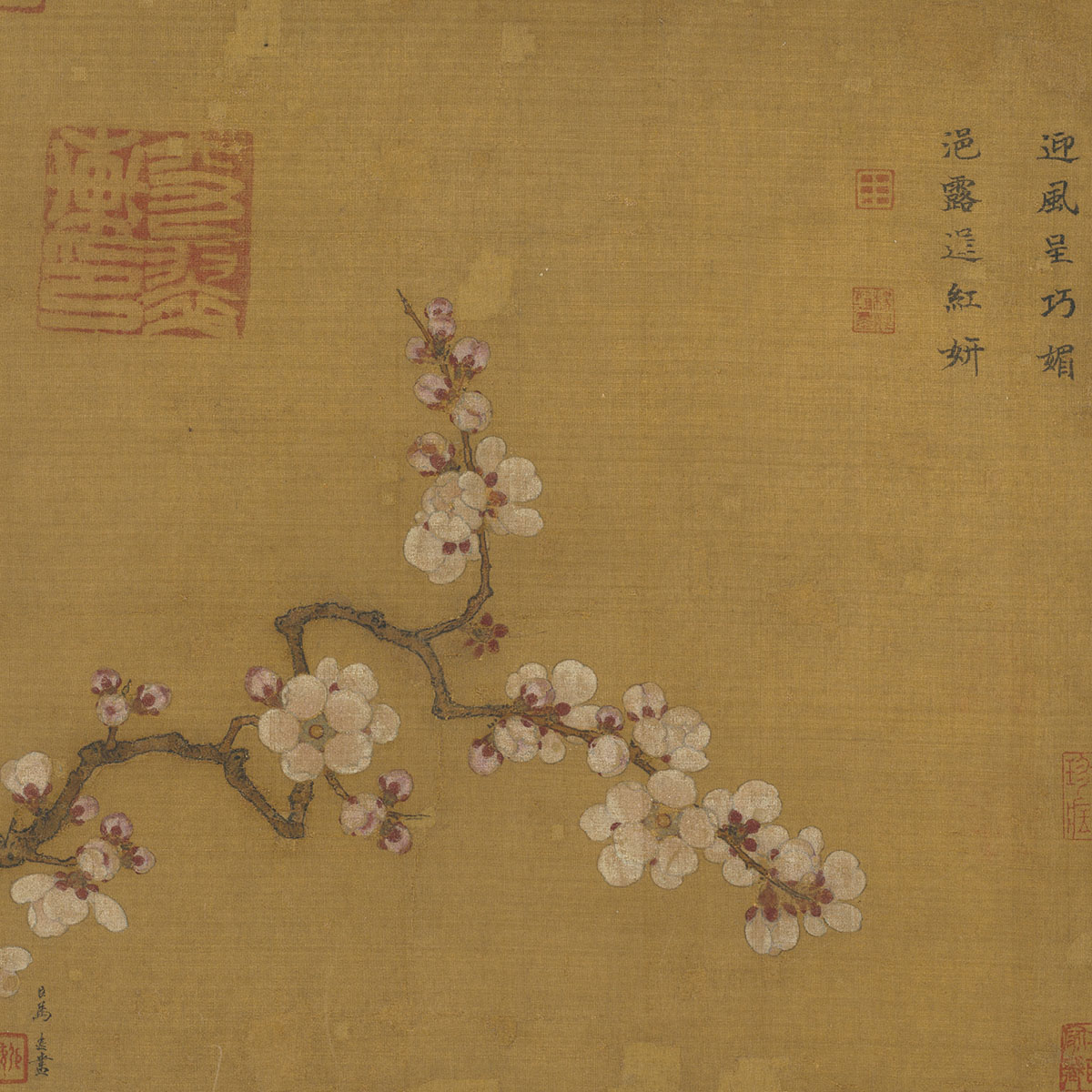
Inscription on Ma Yuan's "Apricot Blossoms"
- Empress Yang (1162-1232), Song dynasty
Madame Yang, a native of Kuaiji, became the empress of Ningzong (reigned 1194-1224). Early on, she was chosen for and entered the palace on account of her graceful looks and then promoted to the rank of empress in 1202.
This painting depicts a branch of apricot blossoms done in exceptionally fine brushwork and delicate colors. The composition is succinct and the coloring refined in this famous intimate work from the hand of the famous Southern Song court artist Ma Yuan (fl. 1189-1225). Moreover, in the upper right corner is a poem inscribed by Empress Yang, the choice of words rhyming and the calligraphy equally refined, making this also an example of the "Three Perfections" (poetry, painting, and calligraphy). Empress Yang's diagonal strokes in the calligraphy have "goose-tail" exaggerations, the brushwork characterized by angularity with a touch of roundness. Compared to the calligraphy of her husband, Empress Yang's has strength within its beauty and grace.
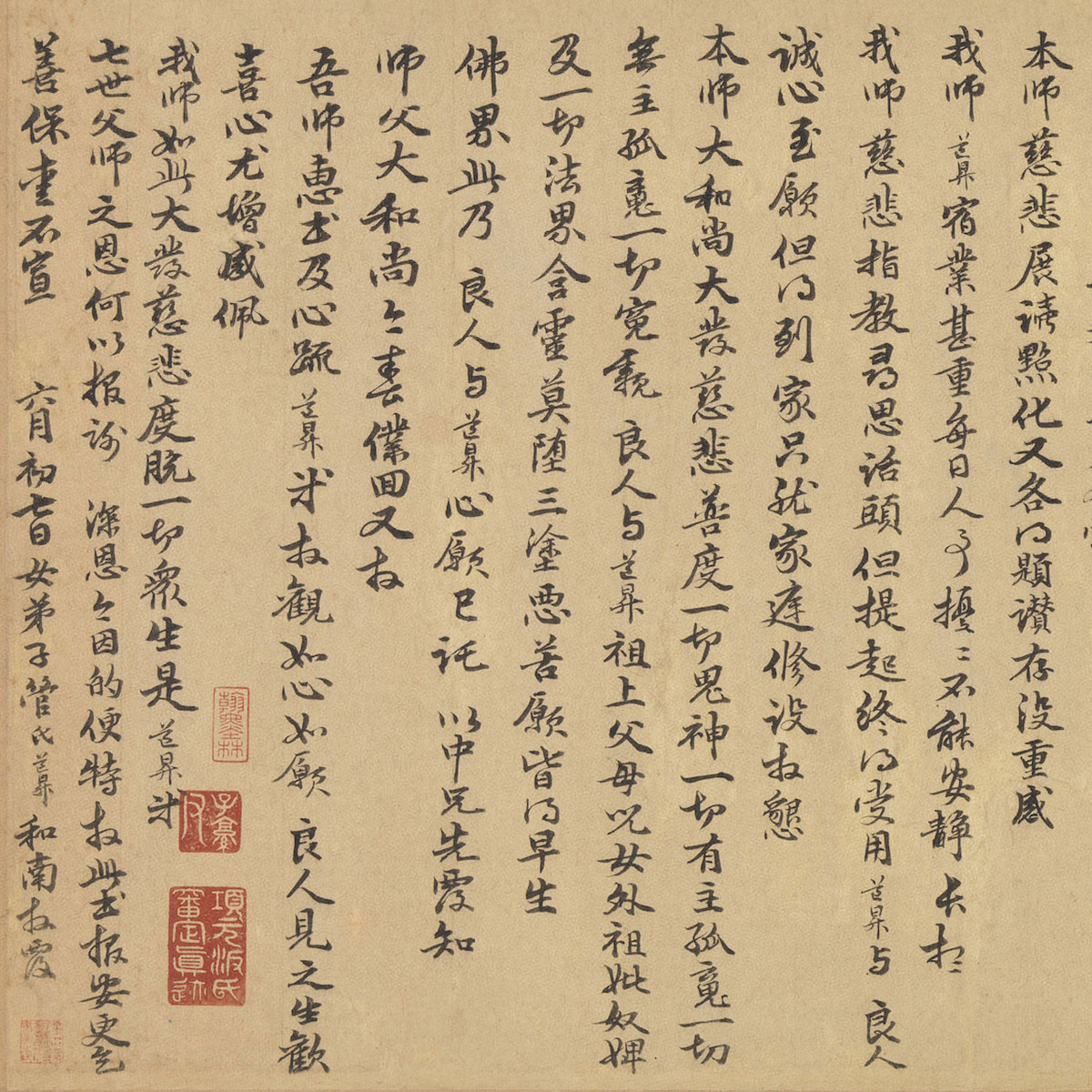
Letter to Abbot Zhongfeng
- Guan Daosheng (1262-1319), Yuan dynasty
Guan Daosheng (style name Zhongji), a native of Zhejiang Province, was the wife of the famous scholar-official artist and Song dynasty scion Zhao Mengfu (1254-1322). She was a devout Buddhist and also excelled at painting bamboo, plum blossoms, orchids, and landscapes as well as Buddhist images.
This work is a letter that Guan Daosheng had written to the famous Buddhist monk Zhongfeng Mingben (1263-1323). She expresses gratitude for her teacher's compassion and beseeches him to say a prayer for the deceased and bring salvation to her family and all sentient beings. The letter is written in a mixture of different script types, including regular, running, and cursive. The brushwork is upright and meticulous, and the letter and cover are mounted together in a single album leaf. The double surname "Zhao Guan" used in her seal offers a glimpse into the tradition of a wife taking her husband's family name.
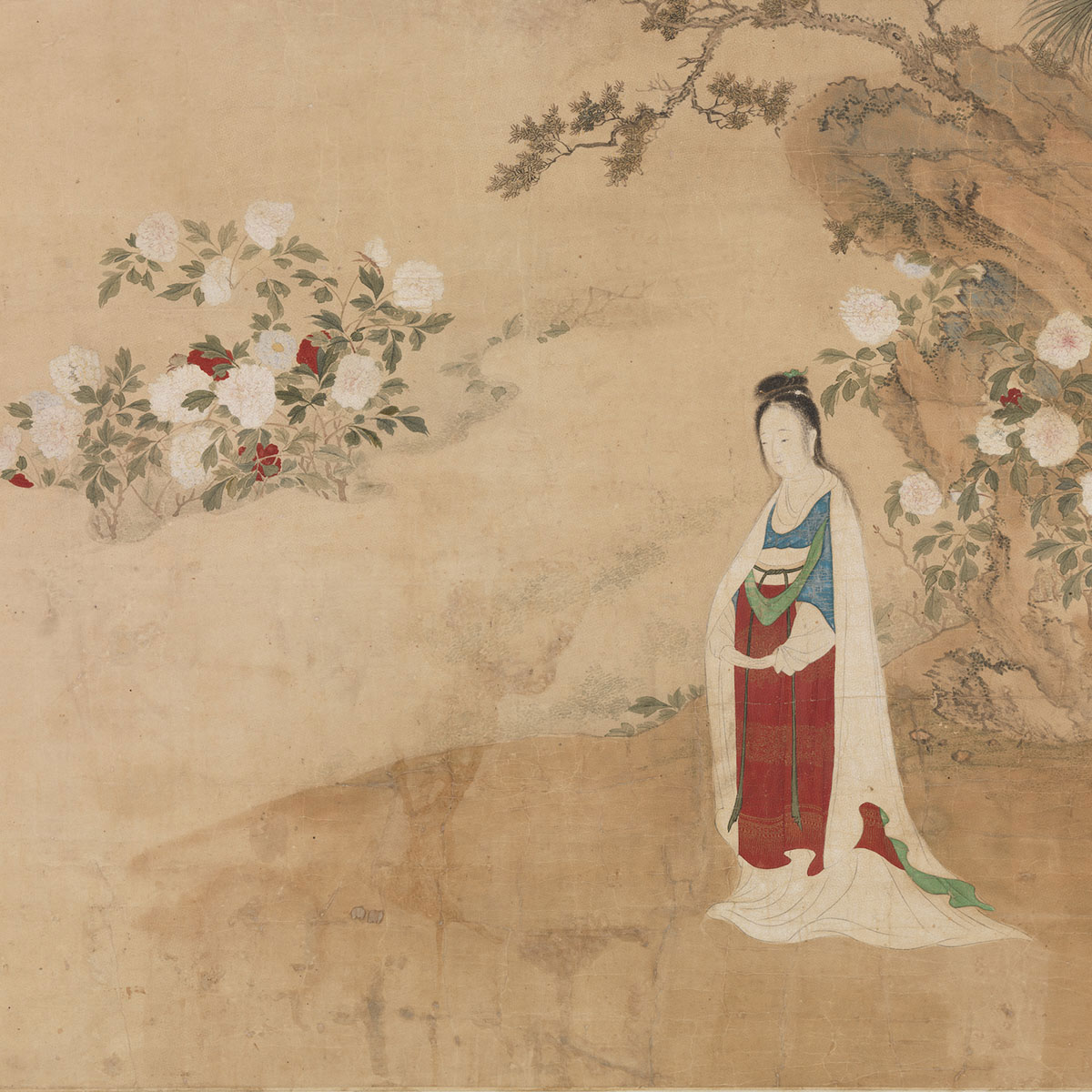
Inspired by a Tang Poet
- Qiu Zhu (16th c.), Ming dynasty
Qiu Zhu (style name Duling neishi) was born in Taicang in Jiangsu and the daughter of the famous painter Qiu Ying (ca. 1494-1552). Diligently following in the family style, the style of her painting was refined and beautiful without a trace of vulgarity.
In this hanging scroll painting, a tree rises upward within a courtyard and is partially covered by a horizontal stretch of clouds. Peonies are in bloom as a lady with light makeup and wearing beautiful clothes stands in front of the flowers and tree. In the lower right is the artist's signature: "Playing sketched by Madame Qiu of Wumen." The figure is painted with particular refinement, the colors beautiful and elegantly classical. In the past, Qiu Ying's painting style had been praised as follows: "Hair of emerald jade and threads of gold, whether he used strands of color or filaments in monochrome, they were of a delicate beauty that even the ancients would not have been dismayed." Such an accolade could equally describe this painting by his daughter as well.
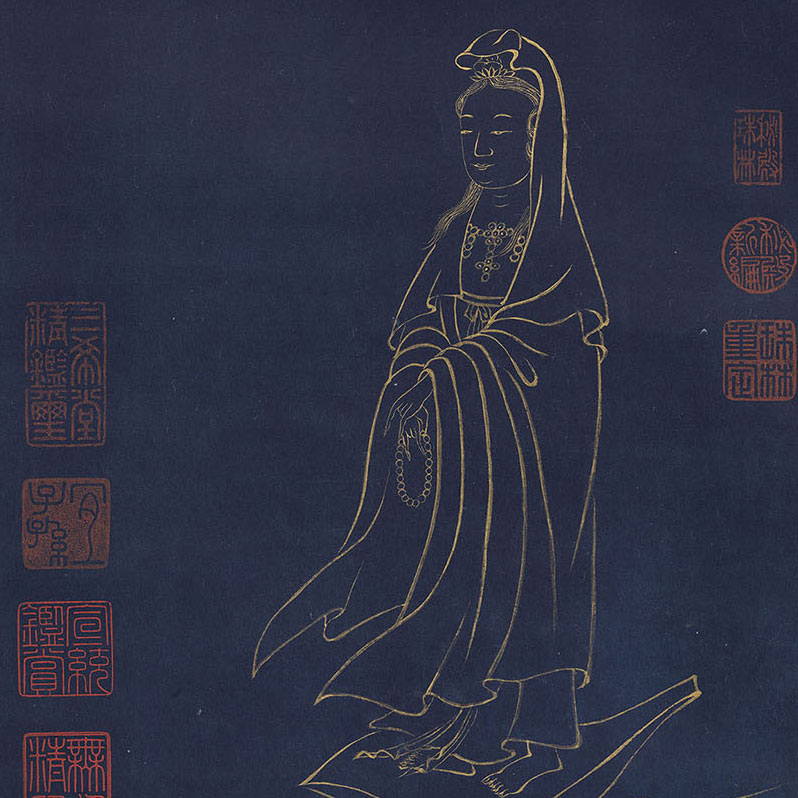
Guanyin Bodhisattva
- Xing Cijing (late 16th-early 17th c.), Ming dynasty
Xing Cijing, a native of Shandong, was the younger sister of the calligrapher Xing Tong (1551-1612). Married to Ma Zheng, the Prefect of Datong, she was also known as "Minister Ma-Xing." She was gifted at painting Guanyin images and flowers in ink, being also good at poetry, verse, and especially prose.
This painting depicts Guanyin, a Buddhist deity known as a bodhisattva and often depicted in later art as a woman. It is done in "baimiao" lines, in which Xing has substituted gold for monochrome ink. In addition, she used dark blue paper to highlight the gold lines, her brushwork succinct and fluid. On the painting is also a eulogy in four lines of eight characters by the artist, in which she expresses her devotion to and reverence for Buddhism as well as her aspirations.
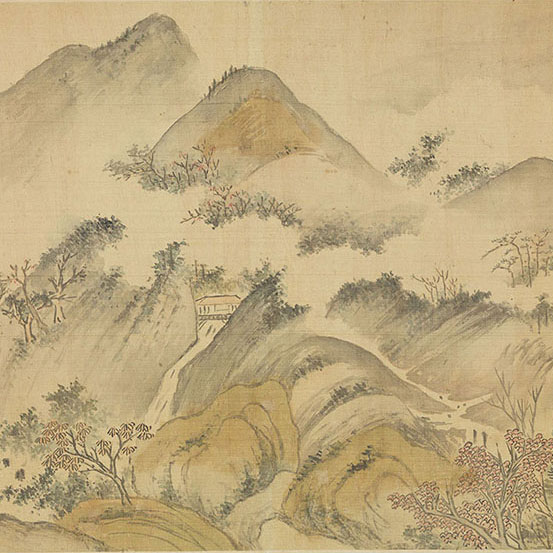
Landscape
- Lin Xue (fl. first half of 17th c.), Ming dynasty
Lin Xue (style name Tiansu), a native of Fujian Province, was a courtesan famous in the West Lake region of Hangzhou. Good at calligraphy and gifted at painting and reciting poetry, her poems are characterized by a ladylike quality. Her landscape paintings feature poised and elegant brushwork with a graceful and appealing effect. She was reportedly so proficient at making copies of ancient paintings that they were difficult to distinguish from the originals.
This painting entrusted to the National Palace Museum from the Lan-ch'ien shan-kuan collection is one of the few landscape painting handscrolls by a woman artist and, in fact, the only one in the Museum collection. This landscape extends for quite some distance with boats and buildings scattered about the water and land, respectively. Exhibiting the soft and misty atmosphere associated with Jiangnan scenery, the work actually focuses more on artistic touches of the brush and ink.
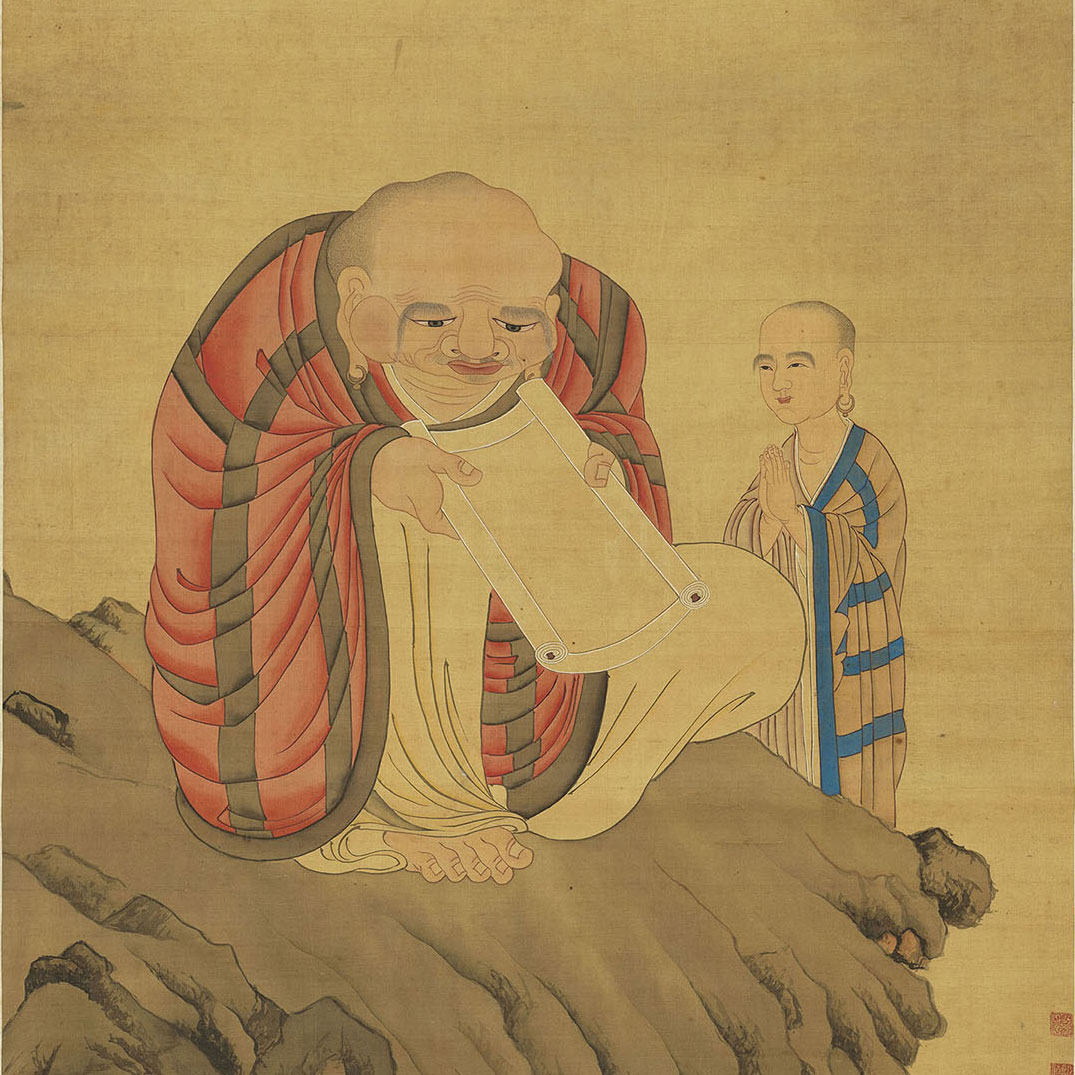
Lohan
- Zhou Xi (1624-ca. 1705), Qing dynasty
Zhou Xi, who also went by the name Shuxi, had the sobriquet Jiangshang nüshi and was from Jiangsu Province. The second daughter of the recluse Zhou Rongqi (1600-1686), she was good at painting bird-and-flower and insect-and-grass subjects but also skilled at Buddhist and Taoist figures.
Zhou painted a total of ten hanging scrolls of lohans, Buddhist figures also known as arhats. She depicted them individually in front of a rock, among trees or with a descending dragon, tame tiger, attendants, or donor figures. The lohans are all shown seated but in a wide range of forms. The brushwork is mature and the coloring beautiful. According to an inscription on the paintings, her set of ten paintings was offered to a Buddhist temple after its completion. Later the set made its way into the Qing imperial collection. The first scroll has been selected for display in this exhibition.
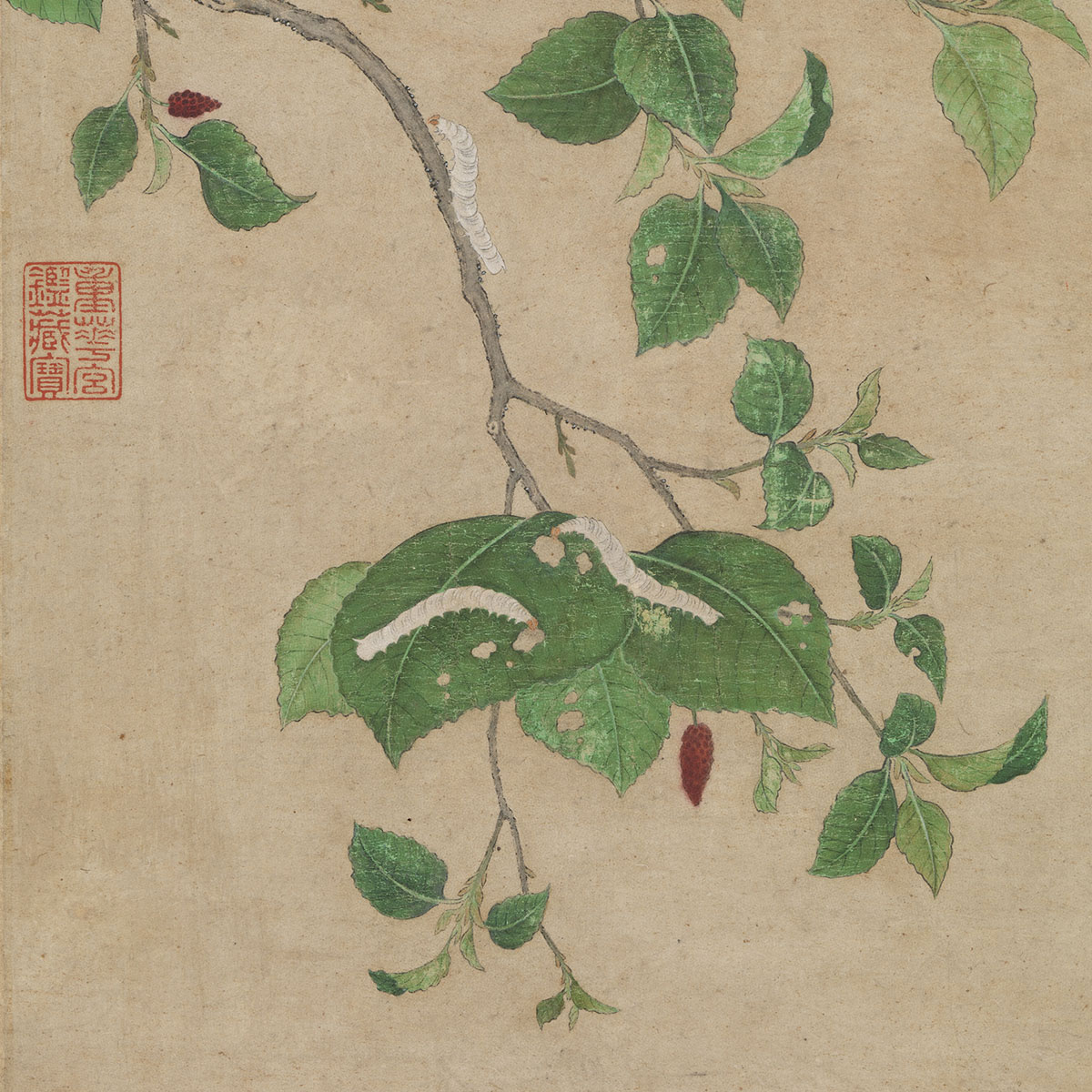
Spring Silkworms Feeding on Leaves
- Wen Chu (1595-1634), Ming dynasty
Wen Chu had the style name Duanrong and was from Jiangsu Province. The daughter of Wen Congjian and the great-granddaughter of the renowned artist Wen Zhengming (1470-1559), she was married to Zhao Jun (style name Lingyun), son of the writer Zhao Yiguang. An intelligent lady, Wen Chu was also gifted at "sketching-from-life" painting and the "fine-line" style of depicting ladies, becoming known as "Best Among Ladies of the (Ming) Dynasty."
This painting depicts a branch of mulberry leaves with its red fruit scattered here and there. Three fattened spring silkworms are slowly making their way in this work full of detail and life. The subject matter is fresh and innovative, the rendering also elegant and exceptionally refined. The colors are lustrous and beautiful as well, expressing harmony in nature and the natural beauty of its colors.

Mountains Still, Days Long
- Chen Shu (1660-1736), Qing dynasty
Chen Shu (style name Fu'an, sobriquet Shangyuan dizi, later taking the self-styled sobriquet Nanlou laoren) was a native of Zhejiang Province. The eldest daughter of University Student Chen Yaoxun and later married to Qian Lunguang (1655-1728) of Haining, she excelled at painting landscapes, figures, and especially bird-and-flower and insect-and-grass subjects. Her eldest son, Qian Chenqun (1686-1774), became a successful statesman and poet, leading the court to award her the title of "Noble Lady."
This painting depicts layers of mountains and ridges with pine trees so thick as to block out the sky in this scene of a lush summer day. The work as a whole builds up complex brush lines, textured strokes, and ink washes to form mountains along with dense "moss dots" rendered using a slanted brush. The continuous manner of the brushwork perhaps is derived from the style of Wang Hui (1632-1717), a famous landscape painter at the court of the early Qing dynasty.
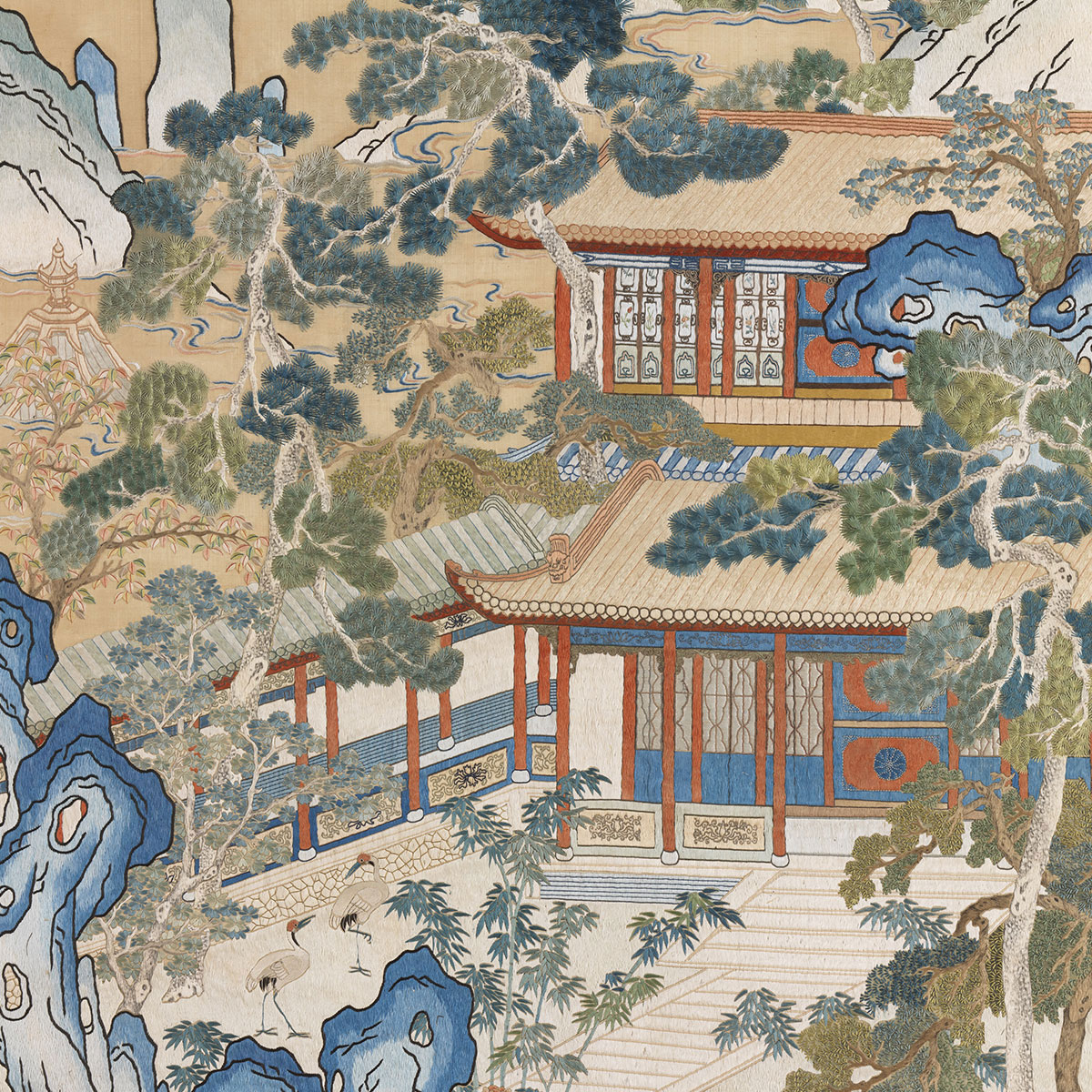
Embroidery of the Painting "Poetic Idea of the Leshou Hall" by the Emperor
- Madame Yu (18th c.), Qing dynasty
Madame Yu, a native of Jiangsu Province, was the daughter of Yu Minzhong (1714-1779), who was a Grand Academician of the Wenhua Hall at court. She married Kong Xianpei (1756-1793) of the official residence of Confucius' descendants; he was a native of Qufu in Shandong and the 72nd generation descendant of Confucius. Her works were published in Posthumous Drafts of Jiulan Pavilion.
This embroidery depicts a scene of buildings and corridors in an architectural complex at the base of mountains. It is based on poetry by the Qianlong emperor (1711-1799) that was also embroidered into this work at the top. The Leshou ("Enjoying Longevity") Hall was built by Qianlong specifically for the sixtieth birthday of his mother. The pure and beautiful colors of this silk embroidery feature silk strands of varying thicknesses using needlework of equal length departure. Coloring for the tree trunks, however, was added using a brush after the embroidery was done to give them a more hoary effect.
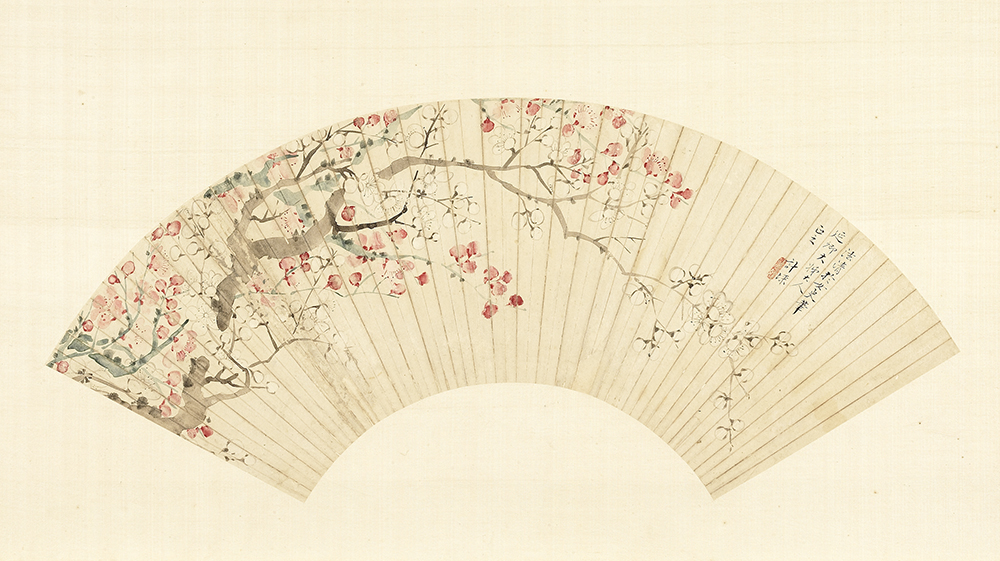
Plum Blossoms
- Ji Cai (19th c.), Qing dynasty
Ji Cai (style name Xiao'e) was from Zhejiang Province and the granddaughter of Ji Nan (1760-1834), who served in Yanzhou as an instructor and excelled at painting plum blossoms. She married a man surnamed Wang from Tongli and once studied poetry from Sun Gushan. Also good at painting and calligraphy, she achieved a name for herself as a "Lady of the Three Perfections."
This painting originally in the format of a folding fan depicts plum branches adorned with numerous red and white blossoms that crisscross each other as they extend across the surface. One branch is rendered in bluish cyanin and light ink using only the "boneless" method of washes, providing a pleasant complement to the light red plum blossoms. The other branch features a mix of ochre and ink to render it in contrast with the white blossoms outlined delicately in light strokes. The free and easy mix of different techniques and delicate colors creates for rich variety within the work.
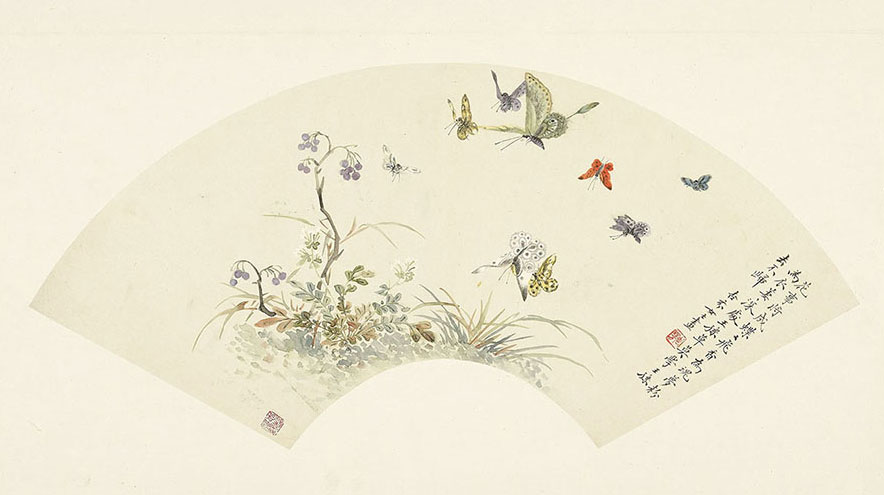
Butterflies and Flowers
- Wu Shujuan (1853-1930), Republican period
Wu Shujuan, who had the late sobriquet Xingfen laoren, was a native of Anhui Province and married to a man from the same hometown. Learning to paint at home since childhood, her landscape and flower subjects were much admired by contemporaries. Also a kind and compassionate person, she donated the profits from selling her paintings to relief efforts in response to natural disasters. A sample of Wu's works can be found in her Painting Drafts of Yinhua Studio.
This painting depicts the corner of a garden where flowers and berries have attracted butterflies to flutter towards them. A moist brush was laden with light colors to directly render the grasses and leaves, to which heavier colors were added for outlining the forms and leaf veins. The butterflies are shown in a variety of poses all using the "boneless" method of washes. The painting is beautifully colored with a touch of pure elegance that is not the least bit gaudy. Mr. Lin Cheng-tao donated this painting to the National Palace Museum.
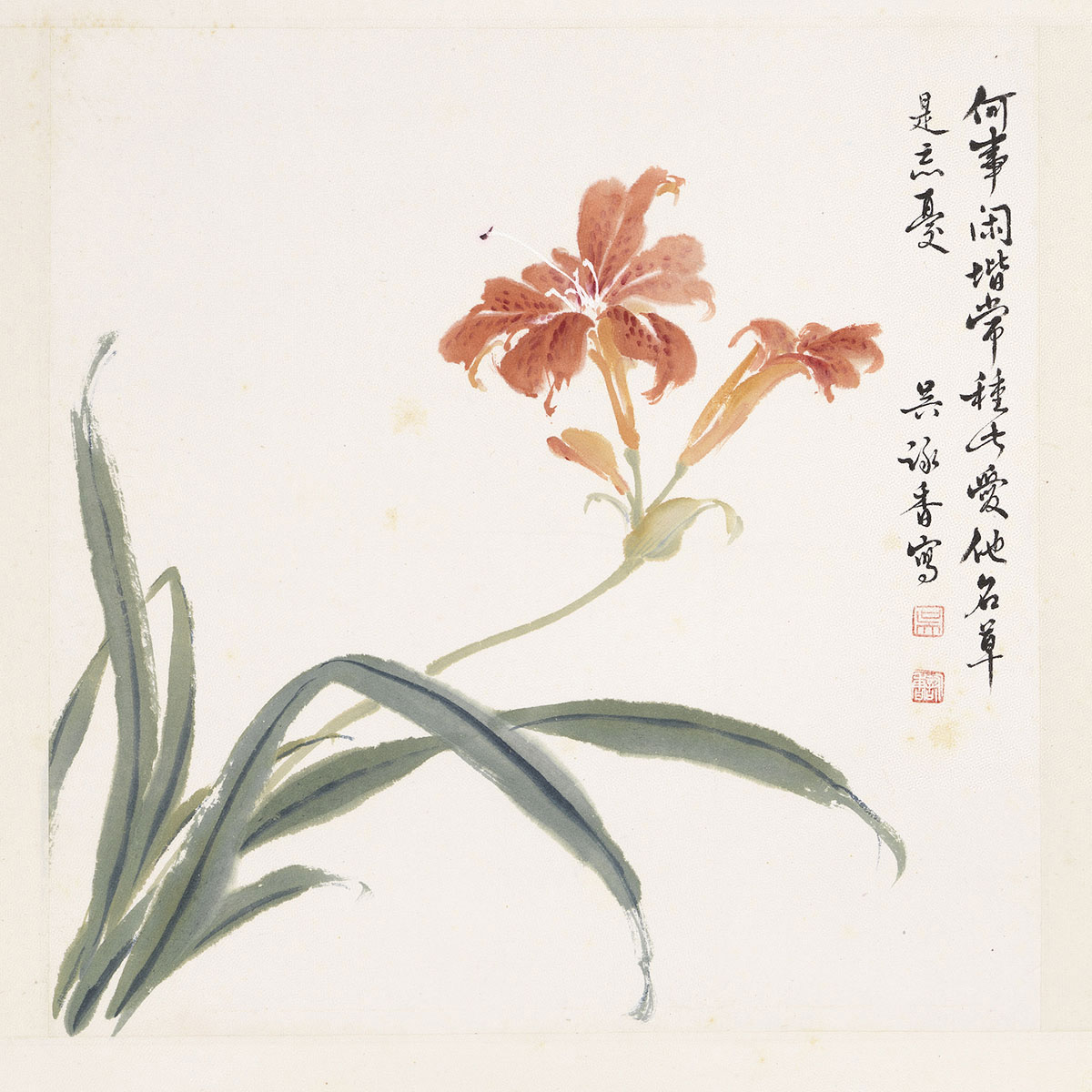
Day Lily
- Wu Yung-hsiang (1913-1970), Republican period
Wu Yung-hsiang, originally from Fujian Province, enjoyed painting since childhood. She went on to graduate from the National Beiping Academy of Art and was taught by such famous painters as Qi Baishi (1864-1957) and Pu Hsin-yu. Her marriage later to Chen Jiuan-fu (1916-1994), a fellow student, became well known in art circles. After coming to Taiwan, she also taught in the Department of Fine Arts at National Taiwan Normal University.
This painting depicts a day lily plant painted using the "boneless" method of washes without outlines. A stalk in blossom and bud emerges from the slender leaves of green. The floral forms are beautifully rendered as the leaves turn in a variety of nuanced manners. The brushwork is quick with evidence of spreading wash colors and traces of "flying white," both of which give the painting a natural dynamism. The orange hues of the day lily blossoms are also tempered in a pleasing manner, revealing the mature and exceptional skill of the artist.




